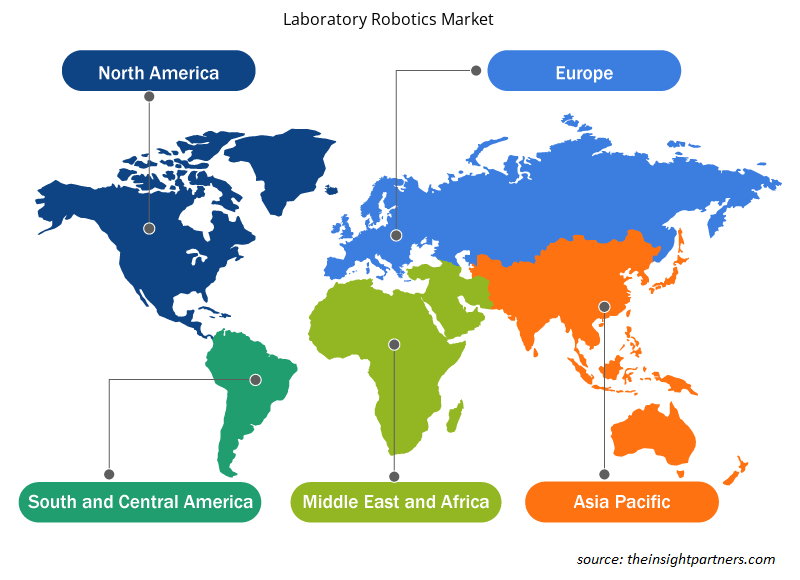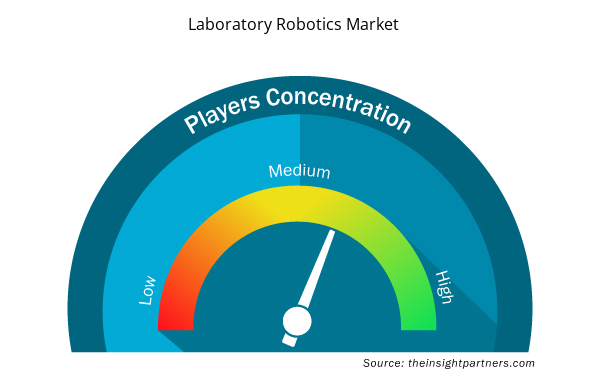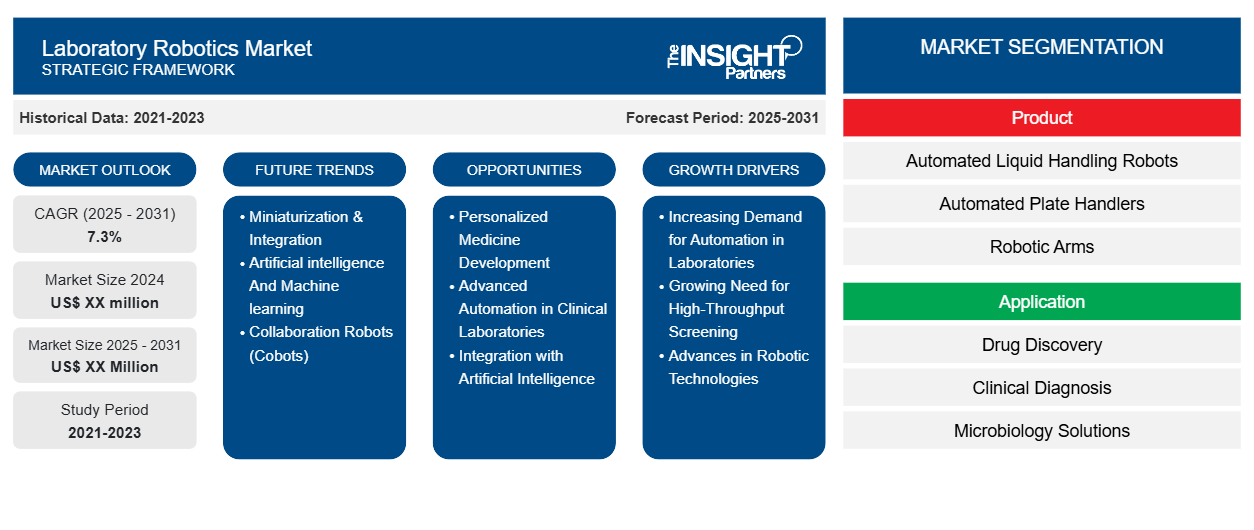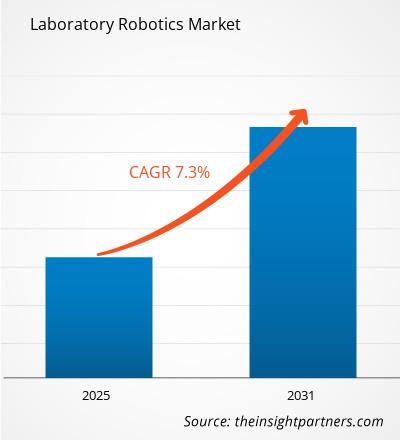Si prevede che il mercato della robotica di laboratorio registrerà un CAGR del 7,3% dal 2023 al 2031, con una dimensione di mercato in espansione da XX milioni di dollari nel 2023 a XX milioni di dollari entro il 2031.
Il rapporto è suddiviso in base a Prodotto (Robot per la manipolazione automatica di liquidi, Manipolatori automatici di piastre, Bracci robotici, Postazioni di lavoro per l'automazione di laboratorio, Lettori e lavatrici di micropiastre e Altri), Applicazione (Scoperta di farmaci, Diagnosi clinica, Soluzioni di microbiologia, Soluzioni di genomica e Soluzioni di proteomica), Utente finale (Laboratorio clinico e Laboratorio di ricerca)
Scopo del rapporto
Il report Laboratory Robotics Market di The Insight Partners mira a descrivere il panorama attuale e la crescita futura, i principali fattori trainanti, le sfide e le opportunità. Ciò fornirà spunti a vari stakeholder aziendali, come:
- Fornitori/produttori di tecnologia: per comprendere le dinamiche di mercato in evoluzione e conoscere le potenziali opportunità di crescita, consentendo loro di prendere decisioni strategiche informate.
- Investitori: condurre un'analisi completa delle tendenze in merito al tasso di crescita del mercato, alle proiezioni finanziarie del mercato e alle opportunità esistenti lungo la catena del valore.
- Enti di regolamentazione: regolamentano le politiche e le attività di controllo sul mercato allo scopo di ridurre al minimo gli abusi, preservare la fiducia degli investitori e sostenere l'integrità e la stabilità del mercato.
Segmentazione del mercato della robotica di laboratorio
Prodotto
- Robot automatizzati per la movimentazione dei liquidi
- Movimentatori automatici di piastre
- Braccia robotiche
- Postazioni di lavoro per l'automazione di laboratorio
- Lettori e lavatrici per micropiastre
- Altri
Applicazione
- Scoperta di farmaci
- Diagnosi clinica
- Soluzioni di microbiologia
- Soluzioni Genomiche
- Soluzioni proteomiche
Utente finale
- Laboratorio clinico e laboratorio di ricerca
Geografia
- America del Nord
- Europa
- Asia-Pacifico
- America del Sud e Centro
- Medio Oriente e Africa
Geografia
- America del Nord
- Europa
- Asia-Pacifico
- America del Sud e Centro
- Medio Oriente e Africa
Personalizza questo report in base alle tue esigenze
Riceverai la personalizzazione gratuita di qualsiasi report, comprese parti di questo report, o analisi a livello nazionale, pacchetto dati Excel, oltre a usufruire di grandi offerte e sconti per start-up e università
- Scopri le principali tendenze di mercato in questo rapporto.Questo campione GRATUITO includerà analisi di dati che spaziano dalle tendenze di mercato alle stime e alle previsioni.
Fattori trainanti della crescita del mercato della robotica di laboratorio
- Domanda crescente di automazione nei laboratori: uno dei principali fattori che stimola la crescita del settore della robotica di laboratorio è la crescente necessità di automazione nei laboratori. Ogni laboratorio desidera massimizzare l'efficienza, l'accuratezza e la produttività e per questo motivo ha già iniziato a utilizzare sistemi affini per eseguire determinati lavori di base e ripetitivi come la preparazione e l'analisi dei campioni, il pipettaggio, ecc. Ciò riduce le possibilità di errore e probabilmente saranno indirizzati più investimenti alla robotica di laboratorio.
- Crescente necessità di screening ad alto rendimento: il settore della robotica di laboratorio sta crescendo a causa della crescente domanda di screening ad alto rendimento durante le fasi di progettazione e sviluppo dei farmaci. Nel processo di sviluppo dei farmaci, i ricercatori devono valutare e sottoporre a screening un numero maggiore di farmaci campione nel periodo di tempo più breve, trovando i composti più promettenti. Le infrastrutture robotiche consentono ai laboratori di progettare test ad alto rendimento con maggiore efficienza e velocità rispetto a quanto sarebbe altrimenti possibile, migliorando i processi di screening farmaceutico e sviluppo diagnostico, accorciando le fasi di sviluppo dei farmaci.
- Progressi nelle tecnologie robotiche: tutte queste innovazioni tecnologiche nella robotica stanno facendo avanzare la posizione dei sistemi robotici di laboratorio verso la prossima frontiera. L'intelligenza artificiale per scopi generali, l'infusione di intelligenza artificiale e l'integrazione delle tecnologie dei sensori sono alcuni dei vantaggi dei robot di laboratorio che hanno portato a soluzioni di automazione sofisticate progettate per attività più complesse che non solo aumentano l'efficacia dei processi operativi a rischio, ma aumentano anche l'estensione dell'utilizzo dei robot di laboratorio.
Tendenze future del mercato della robotica di laboratorio
- Miniaturizzazione e integrazione: l'intera tendenza alla miniaturizzazione e all'integrazione nel mercato della robotica di laboratorio richiede l'uso di sistemi robotici piccoli e multifunzionali. Le tecnologie più recenti consentono ai laboratori di eseguire attività complesse in un'area minore e, cosa più importante, a un costo inferiore. Queste soluzioni robotiche incorporano molte funzioni tra cui, ma non solo, la gestione dei liquidi, il processo e la preparazione dei campioni che forniscono un flusso efficiente di attività, una maggiore produzione e caratteristiche di riproducibilità che i moderni laboratori.
- Intelligenza artificiale e apprendimento automatico: l'intersezione di AI e ML con la robotica di laboratorio cambia il modo in cui vengono gestiti i dati e come vengono prese le decisioni. Tali robot utilizzano dati sperimentali per informare i robot ottimizzati per AI, che possono rivedere le loro procedure e aumentare l'efficienza degli ordini del flusso di lavoro in tempo reale. Di conseguenza, lo sviluppo della ricerca risulta più rapido, più accurato, più lungimirante e i processi di laboratorio sono efficaci e anche adattabili alle esigenze dell'utente.
- Robot collaborativi (cobot): nel contesto di laboratorio, l'uso di cobot, o "robot collaborativi", è in aumento poiché possono essere azionati in presenza di ricercatori umani. Riduce il carico di lavoro degli scienziati poiché la maggior parte dei compiti ripetitivi viene eseguita da robot e gli scienziati possono gestire valutazioni più complesse. Grazie alla loro facilità di utilizzo e adattabilità, i cobot possono tuttavia adattarsi a una miriade di applicazioni, promuovendo così la creatività nella progettazione degli esperimenti e dei progetti intrapresi.
Opportunità di mercato della robotica di laboratorio
- Sviluppo della medicina personalizzata: progressi nella sfera della terapia personalizzata: la capacità della robotica di laboratorio di migliorare e facilitare gli approcci di screening ad alto rendimento la rende una componente cruciale nella medicina personalizzata. I sistemi robotici possono fornire al processo di scoperta dei farmaci una maggiore sofisticatezza e, inoltre, assistere nel processo di somministrazione dei farmaci, in base al genoma della persona, il che migliora i risultati sanitari e i benefici economici.
- Automazione avanzata nei laboratori clinici: la necessità di un test diagnostico di qualità rapido e accurato ha influenzato l'uso della robotica di laboratorio nell'automedicazione clinica. Ciò ha portato a un flusso di lavoro efficiente, riducendo al minimo l'intervento umano e consentendo l'analisi delle informazioni diagnostiche in tempo reale, soddisfacendo così più rapidamente le esigenze dei pazienti. Un cambiamento critico nell'utilizzo dei laboratori clinici ha portato a un aumento della produzione di servizi che sono vantaggiosi per i pazienti poiché i test vengono eseguiti più rapidamente.
- Integrazione con l'intelligenza artificiale: accettazione dell'intelligenza artificiale nell'automazione dei laboratori: con lo sviluppo dell'intelligenza artificiale, è diventata disponibile un'applicazione divertente nell'ottimizzazione delle attività di ricerca nel campo della robotica di laboratorio. I sistemi robotici consentono di raccogliere istantaneamente molte informazioni. L'intelligenza artificiale è in grado di utilizzare queste informazioni e fare entrambe le cose, scoprire che qualcosa non va nelle statistiche e anche come queste statistiche si evolvono nel tempo, il che può essere normalmente troppo avanzato anche per una persona addestrata. L'interfaccia dell'intelligenza artificiale e della robotica ha migliorato la portata della progettazione sperimentale nelle attività e questo ha stimolato l'ingegnosità nella biotecnologia e nella progettazione di nuovi farmaci.
Approfondimenti regionali sul mercato della robotica di laboratorio
Le tendenze regionali e i fattori che influenzano il mercato della robotica di laboratorio durante il periodo di previsione sono stati ampiamente spiegati dagli analisti di Insight Partners. Questa sezione discute anche i segmenti e la geografia del mercato della robotica di laboratorio in Nord America, Europa, Asia Pacifico, Medio Oriente e Africa e America meridionale e centrale.

- Ottieni i dati specifici regionali per il mercato della robotica di laboratorio
Ambito del rapporto di mercato sulla robotica di laboratorio
| Attributo del report | Dettagli |
|---|---|
| Dimensioni del mercato nel 2023 | XX milioni di dollari USA |
| Dimensioni del mercato entro il 2031 | XX milioni di dollari USA |
| CAGR globale (2023-2031) | 7,3% |
| Dati storici | 2021-2022 |
| Periodo di previsione | 2024-2031 |
| Segmenti coperti | Per Prodotto
|
| Regioni e Paesi coperti | America del Nord
|
| Leader di mercato e profili aziendali chiave |
|
Densità degli attori del mercato della robotica di laboratorio: comprendere il suo impatto sulle dinamiche aziendali
Il mercato della robotica di laboratorio sta crescendo rapidamente, spinto dalla crescente domanda degli utenti finali dovuta a fattori quali l'evoluzione delle preferenze dei consumatori, i progressi tecnologici e una maggiore consapevolezza dei vantaggi del prodotto. Con l'aumento della domanda, le aziende stanno ampliando le loro offerte, innovando per soddisfare le esigenze dei consumatori e capitalizzando sulle tendenze emergenti, il che alimenta ulteriormente la crescita del mercato.
La densità degli operatori di mercato si riferisce alla distribuzione di aziende o società che operano in un particolare mercato o settore. Indica quanti concorrenti (operatori di mercato) sono presenti in un dato spazio di mercato in relazione alle sue dimensioni o al valore di mercato totale.
Le principali aziende che operano nel mercato della robotica di laboratorio sono:
- Controlli AB
- Soluzioni di laboratorio automatizzate ALS
- Azienda
- Ingegneria dell'automazione di Cleveland
- Robotica Hudson
Disclaimer : le aziende elencate sopra non sono classificate secondo un ordine particolare.

- Ottieni una panoramica dei principali attori del mercato della robotica di laboratorio
Punti di forza chiave
- Copertura completa: il rapporto copre in modo completo l'analisi di prodotti, servizi, tipologie e utenti finali del mercato della robotica di laboratorio, fornendo una panoramica olistica.
- Analisi degli esperti: il rapporto è compilato sulla base della conoscenza approfondita di esperti e analisti del settore.
- Informazioni aggiornate: il rapporto garantisce la pertinenza aziendale grazie alla copertura di informazioni recenti e tendenze nei dati.
- Opzioni di personalizzazione: questo report può essere personalizzato per soddisfare le esigenze specifiche del cliente e adattarsi in modo appropriato alle strategie aziendali.
Il rapporto di ricerca sul mercato della robotica di laboratorio può quindi aiutare a guidare il percorso di decodifica e comprensione dello scenario del settore e delle prospettive di crescita. Sebbene possano esserci alcune preoccupazioni valide, i vantaggi complessivi di questo rapporto tendono a superare gli svantaggi.
- Analisi storica (2 anni), anno base, previsione (7 anni) con CAGR
- Analisi PEST e SWOT
- Valore/volume delle dimensioni del mercato - Globale, regionale, nazionale
- Industria e panorama competitivo
- Set di dati Excel


- Microplate Reader Market
- Neurovascular Devices Market
- Emergency Department Information System (EDIS) Market
- Explosion-Proof Equipment Market
- Procedure Trays Market
- Integrated Platform Management System Market
- Artificial Turf Market
- Underwater Connector Market
- Wheat Protein Market
- Data Annotation Tools Market

Report Coverage
Revenue forecast, Company Analysis, Industry landscape, Growth factors, and Trends

Segment Covered
This text is related
to segments covered.

Regional Scope
North America, Europe, Asia Pacific, Middle East & Africa, South & Central America

Country Scope
This text is related
to country scope.
Domande frequenti
The laboratory robotics market is estimated to grow with a CAGR of 7.2% from 2023 to 2031.
Asia Pacific region is likely to witness fastest growth rate during the forecast period.
The laboratory robotics market majorly consists of the players such as XX among others.
The market drivers include increasing demand for automation in laboratories and growing need for high-throughput screening are driving the laboratory robotics market
Miniaturization & integration are likely to remain the key trend during the forecast period
North America dominated the laboratory robotics market in 2023
Trends and growth analysis reports related to Life Sciences : READ MORE..
The List of Companies
1. AB Controls
2. ALS Automated Lab Solutions
3. Beckman Coulter Inc.
4. Cleveland Automation Engineering
5. Hudson Robotics
6. Peak Analysis and Automation (PAA)
7. Tecan Group
8. Thermo Fisher Scientific
9. Universal Robots
10. Yaskawa Electric
The Insight Partners performs research in 4 major stages: Data Collection & Secondary Research, Primary Research, Data Analysis and Data Triangulation & Final Review.
- Data Collection and Secondary Research:
As a market research and consulting firm operating from a decade, we have published and advised several client across the globe. First step for any study will start with an assessment of currently available data and insights from existing reports. Further, historical and current market information is collected from Investor Presentations, Annual Reports, SEC Filings, etc., and other information related to company’s performance and market positioning are gathered from Paid Databases (Factiva, Hoovers, and Reuters) and various other publications available in public domain.
Several associations trade associates, technical forums, institutes, societies and organization are accessed to gain technical as well as market related insights through their publications such as research papers, blogs and press releases related to the studies are referred to get cues about the market. Further, white papers, journals, magazines, and other news articles published in last 3 years are scrutinized and analyzed to understand the current market trends.
- Primary Research:
The primarily interview analysis comprise of data obtained from industry participants interview and answers to survey questions gathered by in-house primary team.
For primary research, interviews are conducted with industry experts/CEOs/Marketing Managers/VPs/Subject Matter Experts from both demand and supply side to get a 360-degree view of the market. The primary team conducts several interviews based on the complexity of the markets to understand the various market trends and dynamics which makes research more credible and precise.
A typical research interview fulfils the following functions:
- Provides first-hand information on the market size, market trends, growth trends, competitive landscape, and outlook
- Validates and strengthens in-house secondary research findings
- Develops the analysis team’s expertise and market understanding
Primary research involves email interactions and telephone interviews for each market, category, segment, and sub-segment across geographies. The participants who typically take part in such a process include, but are not limited to:
- Industry participants: VPs, business development managers, market intelligence managers and national sales managers
- Outside experts: Valuation experts, research analysts and key opinion leaders specializing in the electronics and semiconductor industry.
Below is the breakup of our primary respondents by company, designation, and region:

Once we receive the confirmation from primary research sources or primary respondents, we finalize the base year market estimation and forecast the data as per the macroeconomic and microeconomic factors assessed during data collection.
- Data Analysis:
Once data is validated through both secondary as well as primary respondents, we finalize the market estimations by hypothesis formulation and factor analysis at regional and country level.
- Macro-Economic Factor Analysis:
We analyse macroeconomic indicators such the gross domestic product (GDP), increase in the demand for goods and services across industries, technological advancement, regional economic growth, governmental policies, the influence of COVID-19, PEST analysis, and other aspects. This analysis aids in setting benchmarks for various nations/regions and approximating market splits. Additionally, the general trend of the aforementioned components aid in determining the market's development possibilities.
- Country Level Data:
Various factors that are especially aligned to the country are taken into account to determine the market size for a certain area and country, including the presence of vendors, such as headquarters and offices, the country's GDP, demand patterns, and industry growth. To comprehend the market dynamics for the nation, a number of growth variables, inhibitors, application areas, and current market trends are researched. The aforementioned elements aid in determining the country's overall market's growth potential.
- Company Profile:
The “Table of Contents” is formulated by listing and analyzing more than 25 - 30 companies operating in the market ecosystem across geographies. However, we profile only 10 companies as a standard practice in our syndicate reports. These 10 companies comprise leading, emerging, and regional players. Nonetheless, our analysis is not restricted to the 10 listed companies, we also analyze other companies present in the market to develop a holistic view and understand the prevailing trends. The “Company Profiles” section in the report covers key facts, business description, products & services, financial information, SWOT analysis, and key developments. The financial information presented is extracted from the annual reports and official documents of the publicly listed companies. Upon collecting the information for the sections of respective companies, we verify them via various primary sources and then compile the data in respective company profiles. The company level information helps us in deriving the base number as well as in forecasting the market size.
- Developing Base Number:
Aggregation of sales statistics (2020-2022) and macro-economic factor, and other secondary and primary research insights are utilized to arrive at base number and related market shares for 2022. The data gaps are identified in this step and relevant market data is analyzed, collected from paid primary interviews or databases. On finalizing the base year market size, forecasts are developed on the basis of macro-economic, industry and market growth factors and company level analysis.
- Data Triangulation and Final Review:
The market findings and base year market size calculations are validated from supply as well as demand side. Demand side validations are based on macro-economic factor analysis and benchmarks for respective regions and countries. In case of supply side validations, revenues of major companies are estimated (in case not available) based on industry benchmark, approximate number of employees, product portfolio, and primary interviews revenues are gathered. Further revenue from target product/service segment is assessed to avoid overshooting of market statistics. In case of heavy deviations between supply and demand side values, all thes steps are repeated to achieve synchronization.
We follow an iterative model, wherein we share our research findings with Subject Matter Experts (SME’s) and Key Opinion Leaders (KOLs) until consensus view of the market is not formulated – this model negates any drastic deviation in the opinions of experts. Only validated and universally acceptable research findings are quoted in our reports.
We have important check points that we use to validate our research findings – which we call – data triangulation, where we validate the information, we generate from secondary sources with primary interviews and then we re-validate with our internal data bases and Subject matter experts. This comprehensive model enables us to deliver high quality, reliable data in shortest possible time.


 Ottieni un campione gratuito per questo repot
Ottieni un campione gratuito per questo repot